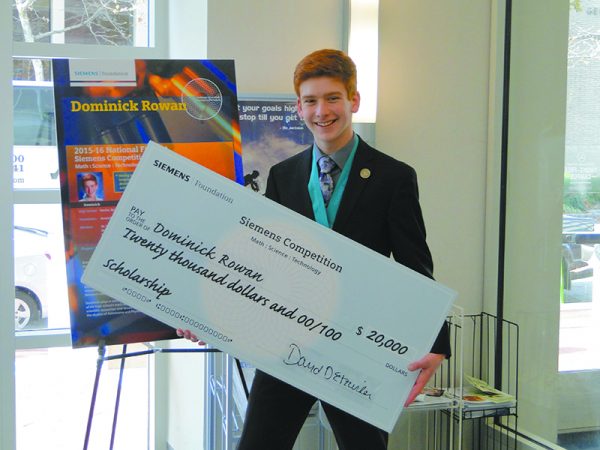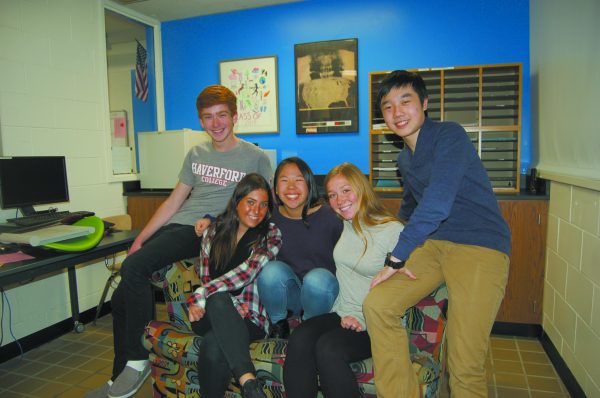
By Brian Donnelly
Are we alone in the universe?
It’s a profound question that has inspired countless science fiction thrillers, star gazers and, of course, 17-year-old Dominick Rowan to discover a planet 119 light-years away. “Exoplanet detection is kind of on the forefront of astronomy research,” he said, explaining that an exoplanet is a planet that orbits a star other than the sun.
Yes, this Byram Hills High School senior and Authentic Science Research Program standout is on the forefront of the forefront; a place that, unlike space, is particularly finite. “It’s kind of a little outside my grasp sometimes to think that, ‘Wow, there’s astrophysicists all over the world looking for planets and I just happened to find one,'” he said, his self-assured tone contradicting his overall youthful sentiment. “In that sense it was a happy accident.”
Intellectual Integrity Wins
Accident or not, it’s impressive. Just ask his teachers. “He’s confirmed my belief that age is not a limitation in accomplishment and that hard work and intellectual integrity win out over almost everything,” said David Keith, director of Byram Hills High School’s Authentic Science Research Program. “Here’s a kid who for all intents and purposes shouldn’t be able to do this level of work at his age, and he did; and he does.”
The program is a three-year science elective course in which students pick a topic, identify and work with a mentor in a related field and produce an original piece of research. The model has caught on in high schools across the country in the last decade, but Byram Hills High School was way out in front, launching its program in 1989.
“This is one of the very first organized science research programs,” Keith touted, “and after it became accredited by the State University of New York well over 100 districts adopted this curriculum. So, while everybody adds their own flavor and changes it to suite their district’s needs, a lot of the schools started it based on the idea put forth by Dr. [Robert] Pavlica. it was an ingenious concept.”
Pavlica founded the program with just one student and used the methods he learned as a Ph.D. candidate in biochemistry at St. John’s University to structure the program, according to a 2001 New York Times article. In its 27-year history the program has produced 96 semifinalists and 18 finalists in the prestigious Intel Science Talent Search. That includes five semi-finalists this year: Sela Berenblum, Kevin Chang, Lyndsay Siegle, Sarah Tang and, of course, Rowan. He was also a finalist in the Siemens Competition in Math, Science and Technology in late 2015 and presented his research to a panel in Washington D.C. Both competitions offer scholarship money to finalists.
Keith became director of the program, named for its founder, in 2005. Since then, the program has doubled in size with 100 students participating this year. “One of the goals of this kind of program is that, if you’re successful, by the end you’re teaching your teachers,” he said. “That’s a very compelling idea for a student… How wonderful is it to be 17 years old and be able to say, ‘I know more than my teachers about this subject and maybe for a brief moment I was the only person in the world who knew something; who had discovered something.”
When students enter high school they can apply for the program, a process that differs by school district. “We actually have been somewhat unique in that we never consider a student’s grade performance as a final indicator as to whether they qualify or not,” said Keith, who is certified to teach physics and earth science. “It’s really up to the student to engage their own passion in science.” He continued, “For Dominick he came in already having a very strong passion for astronomy. He knew that he loved the physical sciences so he was an easy student to facilitate.”
In his sophomore year while searching through some suggested topics, Rowan came across articles on exoplanet research. “It wasn’t really a lot of work,” he said. “It was more of exploring an interest.” The more he dug up on the topic the more sophisticated his project became. “I wanted to look at planets’ habitability to see if planets would be suitable for life as it is on ours,” he said.
To do that he used statistical analysis to identify planets similar to Jupiter in other solar systems. In the formation of this solar system Jupiter’s migration towards the sun and then back out into its position presently served as a vacuum cleaner and got rid of a lot of debris that could’ve impacted and destroyed the earth, Keith said. Rowan added that discovering how common that is in other solar systems can help determine how common earth-like planets would be and, therefore, how common life is.
One day he noticed a Jupiter-like planet that hadn’t been referenced previously. “The numbers weren’t lying to me,” he recalled. The planet hunter brought the discovery to his mentor, who confirmed it.
“I love the fact that this lucky accident happened to him,” Rowan’s biology teacher, Stephanie Greenwald, said of his discovery. “He is such a humble, endearing young man and was genuinely excited every step of the way.”
For his contribution, Rowan’s mentor, Dr. Stefano Meschiari, made him lead author on the research paper, which was published in late January in The Astrophysical Journal.
“To me it’s not about the age, it’s about the research,” he said, expressing a hope that their research will help further research on the commonality of other solar systems. “Because I think that anyone in my position, anyone who has access to the science research program could have utilized their tools in the same way I could have. And a bunch of students are with other projects.”
In addition to the other four Intel semi-finalists, seniors Brian Singer and Ryan Infante are two more examples of that success. They are two of the four finalists in the country for the American Academy of Neurology Neuroscience Research Prize.

“I think the spreading of science research as a curriculum like this to as many schools as possible, even though it may reduce the number of awards that we can get as one school, it’s just so right.” As for the Haverford College-bound Rowan, Keith said he is an “example of things going right in public education, and parenting.” While his planet has been labeled HD32963b–not his first choice–his father, Mike Rowan, seems to think he’ll get another crack at it someday.
“It looks like he’s found something that he’s really interested in and will put all his energy into it,” he said, supporting his son’s aspirations to become an astrophysicist. “And I’m sure he’ll make something out of it and in the end maybe he devotes his time to research and pursuing this and we find another solar system to live in.”
Brian Donnelly is a freelance reporter and public relations specialist. Born in Mamaroneck, he has lived in White Plains and Cortlandt Manor.
